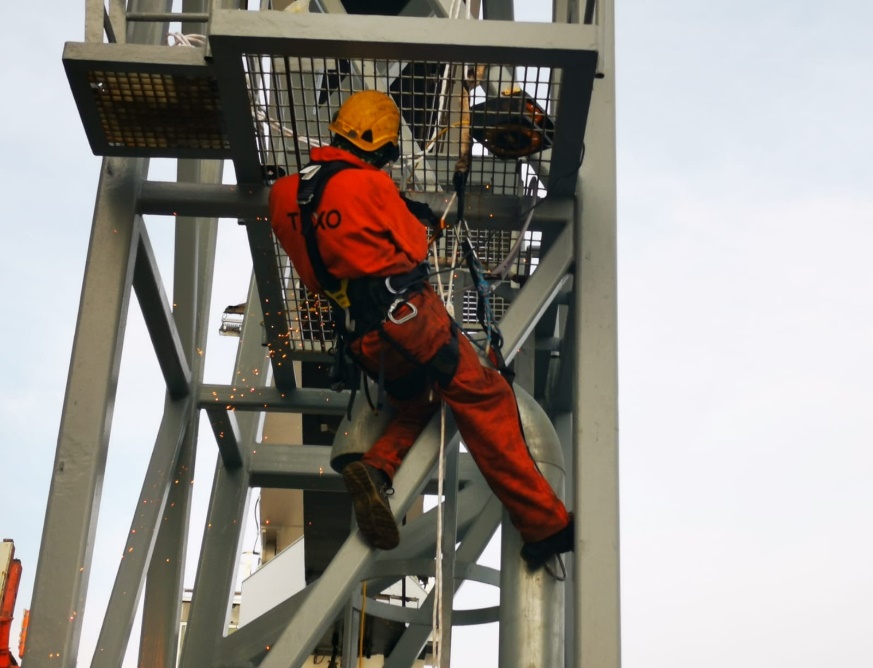News
A professional dropped objects survey could save your people – and your business

Steve Ure, Operations Manager – TEXO Asset Integrity
In November 2014, a man was killed on a construction site in New Jersey, USA, after a tape measure dropped on him from 50 storeys above. The measure had become dislodged from a worker’s belt, and the victim hadn’t put on a hard hat.
This, and the many stories like it, demonstrate just how critical it is for companies to regularly assess their sites for potential drop hazards and have mitigation measures in place that protect both workers and civilians.
It’s an issue that’s not confined to construction sites, of course. Everyday working environments present potential dropping hazards from a variety of sources – from human error to poorly maintained catches, rope arrangements or component failure. Many companies have a ‘standard’ risk assessment for this area, which often does not go far enough either in terms of in-depth inspection of all areas of potential hazard, or in repairing and maintaining equipment to prevent drop issues in the future.
The DROPS scheme
The Dropped Object Prevention Scheme is an industry-wide initiative focused on preventing damage and injury caused by dropped objects. A Global Work Group, DROPS is represented by 200 operators, contractors, service companies and industry bodies, all sharing a commitment to preventing accidents caused by dropped objects, which remain a leading threat to both personnel and operations across many industries.
Here, we answer the most common questions about dropped objects, and demonstrate why it is in the interests of everyone in – or visiting – your organisation to ensure that a regular dropped object survey is carried out as part of your standard Health & Safety programme.
What is the definition of a dropped object?
A ‘dropped object’ is any item that falls from its previous position. This covers all items, materials or objects of any size, mass or density. As a rule, dropped objects are usually classified as static or dynamic:
- A static dropped object is any object that falls from its previous position under its own weight (gravity) without any applied force. As an example, a static object may drop because it is poorly secured, because it has been dislodged with vibration in the environment, or because its casing or fixing has failed.
- A dynamic dropped object falls because it has had force applied to it. It may have been dislodged by other operations, by a collision, or being snagged or moved by other machinery. For outdoor locations, the object may also have been dislodged in poor weather conditions.
Are you confident that you are covering this risk properly? Failing to understand, note or mitigate against potential drop risks could result in:
Injury to personnel – as we saw from the story at the start of this article, dropped objects can kill. They can also cause life-changing injuries. It is the company’s responsibility to ensure that this cannot happen. Part of your dropped object assessment is to make provision for objects that are over walkways, pavements, public areas and more, helping you to reduce the risk to anyone using your site.
Damage to equipment – expensive and with potential downtime if something critical is damaged, most companies want to avoid anything that will damage equipment. Attention to detail in a dropped objects survey will help you to protect your assets.
Disruption to your business – having to shut part of your production line, or halt a particular team while you sort out a dropped object problem is costly. By mitigating these risks and having clear plans and procedures in place, you can minimise downtime and keep your business running smoothly.
On-site inspections – certain accidents or incidents have to be reported to external bodies, who will then send a team to conduct a full inspection. This can result in fines, prosecution and business shut-down – and even if an inspection is clear, it will cause considerable disruption to your business.
Damage to your safety reputation – for many businesses, health and safety records are vital to reputation and client relationships. Any indication that you are not taking your H&S responsibilities seriously could result in losing business and long-lasting damage to your reputation in your industry.
Poor staff retention – people don’t want to work somewhere they don’t feel safe. If you’re not checking the safety of your working environment and providing the right safety equipment to your staff, you are likely to experience people leaving and trouble recruiting.
Losing an existing contract – if you are responsible for a dropped objects incident on a client site, or even at your own site where you are working on client products, you may find that you lose the contract. Customers will have high health and safety standards and will not want to be associated with a company that doesn’t protect people and equipment.
Choosing a DROPS survey specialist
Our clients have found that it is more efficient and effective to bring in trained dropped object specialists. You can be confident that all areas are properly surveyed, considered, reported on and mitigations suggested, and it also gives you an opportunity to see which areas need better maintenance or repair in order to meet H&S requirements.
TEXO – a dropped object specialist. We provide detailed inspection of your asset, conducted by rope access and drone inspection where needed. Our surveys highlight and remove current drops risks. We also install any safety equipment required to remove drop risks and deliver and easy to follow, level by level follow up pack with clear photographic reference detailing all items. If you think your business would benefit from our dropped objects expertise, contact us to find out more.